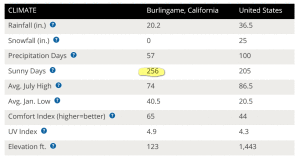There has always been a perception that New York is a very exclusive place. Of course, when you stack 1.6m people in the tiny little area of Manhattan, and 8,4m in the city as a whole, it will cause some pricing pressure. At an average cost of $3,692 for a 2 bedroom apartment though, New York is starting to look cheap to San Francisco’s $5,043.
Just how crazy is it that you need to make over $216,000 in salary for that to be affordable? Well, you need to be in the top 5% of income earners in the US – that’s how crazy it is. And the fact is that most people in San Francisco cannot afford living there – by a long shot.
Just how big is the problem? I’m sure everyone in SF just gets paid through the nose, which is why it does not matter? Well, let’s look at median house price compared to median income. It’s largely believed that a ratio higher than 3 causes issues, i.e. when you have to pay 3 times your gross annual income for a house, it starts becoming painful. How does San Francisco stack up here? It’s largely creeping towards 10x!
In San Francisco, the price to buy or rent is 2-3 times higher than the US average. If you look at the recent growth, 7 figure house prices have gone from 19.6% to over 50% since 2012 (Btw, if you click the link, note that the top 3 cities are all in the Bay Area).
This means in general living in the Bay Area means you are screwed. People in your company in those other offices around the US likely experience significantly less financial stress and have a significantly higher disposable income. Take into effect that California also has a state income tax, one wonders when you’ll start seeing armadas of U-Haul trucks. Thank goodness there is one positive stat:
One cannot dismiss the fact that the Bay Area has a problem. The un-affordability does not stop with housing. High cost of living drives up the prices for other goods and services as inhabitants struggle to survive. For instance, a nice 3 course meal in SF is 50% more expensive than say Austin, Texas – another tech hub. Of course you can cut down on dining, and you can stay less fit (which costs 60% more), but if you have kids for instance and need to send them to daycare, well then expect to pay through the nose.
If you think this just leads to self-selection and no issues in society, think again. Crime is on the rise in virtually every category, and in general, income inequality has been very closely linked to “unhappiness” or societal issues. The Bay Area is arguably the world’s most important hub for innovation in technology, but if nothing is done over the long term this advantage could disappear. Will it be bad for innovation? Probably not, as capital and talent can flock elsewhere even though the Bay area still has a lead on this:
However, as international talent is highly sought to drive this innovation, as 60% of top 25 startups are funded by 1st or 2nd generation immigrants, the high cost of living combined with outdated immigration laws helps drive or keep talent overseas. If you do not think this will have an impact on the Bay Area at some point you need to think again.
So what can be done? And is there any willingness to do anything? Rent control may be one answer, but there are arguments it may not work. The other answer seems to be to increase supply and build more housing. San Francisco seems to be way behind on this front, where 40% of SF’s housing was built prior to 1940, and even the new units being built seem to appeal only to the very wealthy. So where will this end for the Bay Area, for entrepreneurs, for innovation? Will it be Tulsa, here we come? Somehow doubt that, but only time will tell it seems…




Recent Comments